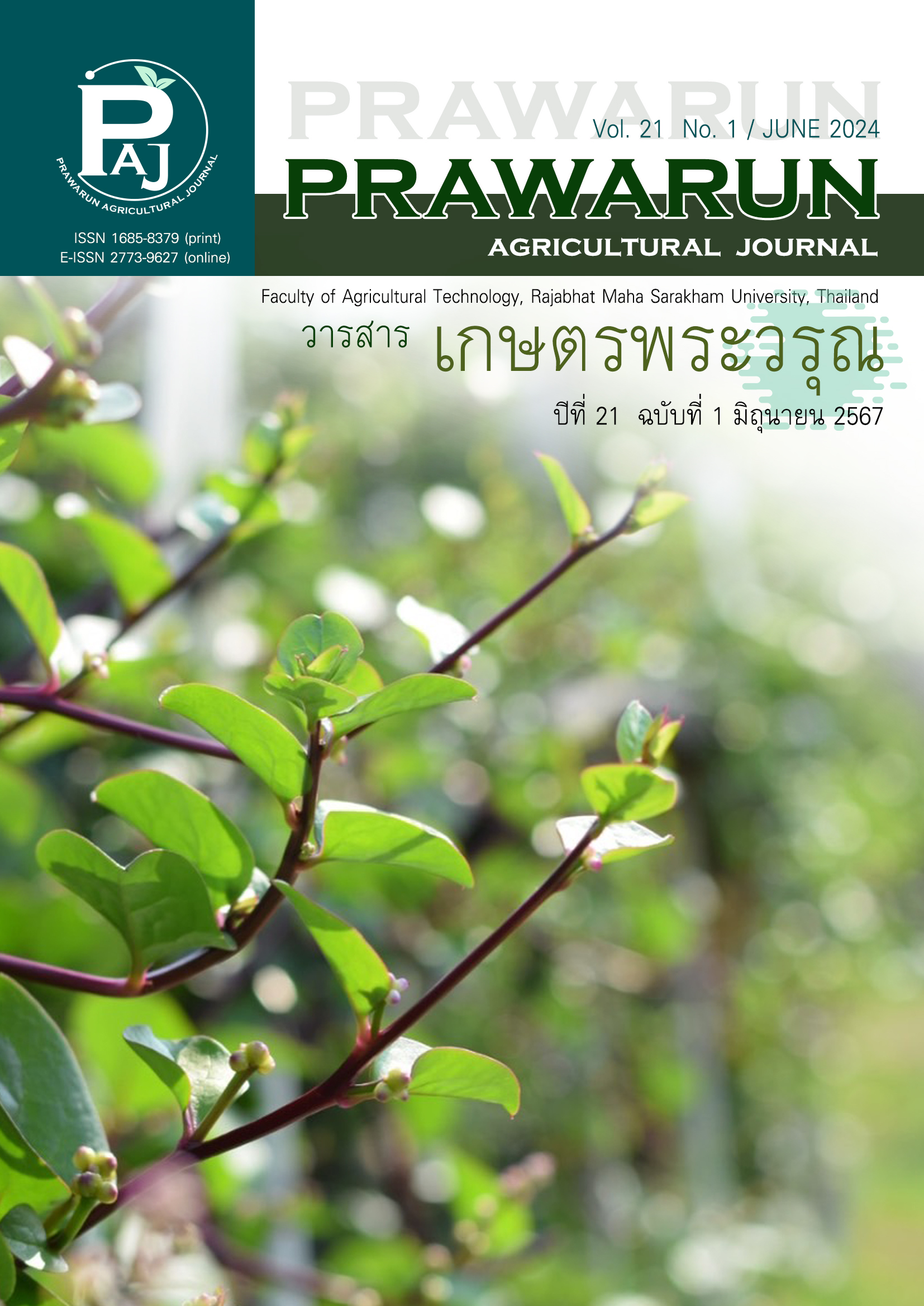อิทธิพลของปุ๋ยฮอร์โมนปั้นเม็ดสูตรผสม (HO) เพื่อเพิ่มผลผลิตและสารสำคัญของกะเพรา (Ocimum tenuiflorum L.)
Main Article Content
บทคัดย่อ
การวิจัยมีวัตถุประสงค์เพื่อศึกษาอิทธิพลของปุ๋ยฮอร์โมนปั้นเม็ดสูตรผสม (HO) มีผลต่อคุณสมบัติของดิน การเจริญเติบโต ผลผลิต องค์ประกอบผลผลิต และสารสำคัญของกะเพรา (Ocimum tenuiflorum L.) วางแผนการทดลองแบบ RCBD ประกอบด้วย 6 กรรมวิธี จำนวน 4 บล็อค ใส่ปุ๋ยตามกรรมวิธีดังนี้ T1) ไม่ใส่ปุ๋ย (control) T2) ปุ๋ยเคมี 15-15-15 T3) ปุ๋ยอินทรีย์ T4) ปุ๋ยฮอร์โมนปั้นเม็ดสูตรผสม-1 (HO-1) T5) ปุ๋ยฮอร์โมนปั้นเม็ดสูตรผสม-2 (HO-2) และ T6) ปุ๋ยฮอร์โมนปั้นเม็ดสูตรผสม-3 (HO-3) อัตรา 50 กิโลกรัมต่อไร่ โดยนำต้นกล้ากะเพราปลูกในแปลง และใส่ปุ๋ยตามกรรมวิธี พบว่าดินหลังการทดลองในกลุ่มปุ๋ยฮอร์โมนปั้นเม็ดสูตรผสมหรือกลุ่มปุ๋ย HO (T4 T5 และ T6) ช่วยเพิ่มอินทรียวัตถุ และปรับสภาพความเป็นกรด-ด่าง (pH) เพิ่มความพรุน เพิ่มความสามารถในการอุ้มน้ำ และกลุ่มปุ๋ย HO มีธาตุอาหารรองและธาตุอาหารเสริมเพิ่มขึ้นอย่างมีนัยสำคัญ อิทธิพลของปุ๋ยต่อการเจริญเติบโต ผลผลิตและองค์ประกอบของกะเพรา พบว่ากลุ่มปุ๋ยฮอร์โมนปั้นเม็ดสูตรผสม HO ทำให้กะเพรามีขนาดลำต้นใหญ่ขึ้นแตกต่างอย่างมีนัยสำคัญทางสถิติกับกรรมวิธีอื่น ๆ และมีขนาดทรงพุ่มไม่แตกต่างกับปุ๋ยเคมี ด้านผลผลิตกลุ่มปุ๋ยฮอร์โมนปั้นเม็ดสูตรผสม HO ส่วนใหญ่ทำให้ผลผลิตเพิ่มขึ้น ใน T5 (HO-2) 1,736.30 กิโลกรัมต่อไร่ และ T2 (ปุ๋ยเคมี15-15-15) 1,735.80 กิโลกรัมต่อไร่ ให้ผลผลิตสูงสุดแตกต่างอย่างมีนัยสำคัญกับกรรมวิธีอื่น ๆ ปริมาณสารสำคัญยูจินอล และเมทิลยูจินอล ใน T5 (HO-2) แสดงผลสูงสุดเหนือกรรมวิธีอื่น ๆ จึงสรุปได้ว่าปุ๋ย HO โดยเฉพาะ T5 (HO-2) สามารถปรับปรุงโครงสร้างดิน และช่วยเพิ่มธาตุอาหารให้แก่ดินได้พร้อม ๆ กับการใส่ปุ๋ย
Article Details
เอกสารอ้างอิง
Ahmad, I., Asif, M., Amjad, A., & Ahmad, S. (2011). Fertilization enhances growth, yield, and xanthophyll contents of marigold. Turkish Journal of Agriculture and Forestry, 35(6), 641-648. doi: 10.3906/tar-1005-995
Canellas, L. P., Olivares, F. L., Okorokova-Façanha, A. L., & Façanha, A. R. (2002). Humic acids isolated from earthworm compost enhance root elongation, lateral root emergence, and plasma membrane H+ -ATPase activity in maize roots. Plant physiology, 130(4), 1951-1957. doi: 10.1104/pp.007088
Chuaynon, C., & Intanon, P. (2011). Development of high-quality bio-fertilizer for rice production. Naresuan University Journal, 19(2), 8-18. (in Thai)
Hussein, M. M., Sakr, R. A., Badr, L. A., & Mashat, K. M. A. L. (2011). Effect of some fertilizers on botanical and chemical characteristics of pot marigold plant (Calendula officinalis L.). Journal of Horticultural Science & Ornamental Plants, 3(3), 220-231.
Intanon, P. (2009). Fertilizer Technology. Phitsanulok, Thailand: Naresuan University. (in Thai)
Intanon, P. (2013a). Comparison of fertilizer management to increase yield and quality of rice. International Journal of Environmental and Rural Development, 4(2), 9-14. doi: 10.32115/ijerd.4.2_9
Intanon, P. (2013b). The influence of different types of fertilizers on productivity and quality of maize in the area of Kwaew Noi Bamrungdan Dam, Phitsanulok Province, Thailand. International Journal of Environmental and Rural Development, 4(2), 15-20. doi: 10.32115/ijerd.4.2_15
Intharaphu, S. (2013). Development of high-quality biological fermentation for increasing rice production (Master’s thesis). Khon Kaen, Thailand: Faculty of Agriculture Khon Kaen University. (in Thai)
Jubkaew, S., & Intanon, P. (2012). Effect of hormones compound granular fertilizer on growth and yield of rice. Khon Kaen Agriculture Journal, 40(Suppl. 4), 105-109.
Mady, M. A., & Youssef, A. S. M. (2014). Influence of some fertilizers and boron foliar spray on improving growth and oil productivity of dragonhead (Dracocephalum moldavica L.) plant. Journal of Plant Production, 5(4), 587-613. doi: 10.21608/JPP.2014.53727
Nurzyńska-Wierdak, R., Bogucka-Kocka, A., Kowalski, R., & Borowski, B. (2012). Changes in the chemical composition of the essential oil of sweet basil (Ocimum basilicum L.) depending on the plant growth stage. Chemija, 23(3), 216-222.
Office of the Nation Economic and Social Development Board. (2018). Nation Strategy 2018-2037. Accessed October 13, 2018. Retrieved from https://www.ratchakitcha.soc.go.th/DATA/PDF/2561/A/082/T_0001.PDF (in Thai)
Raksarikorn, C., Phasee, P., & Intanon, P. (2012). Effect of chemical fertilizer and chemical and granular organic fertilizer with hormones mixed formula on growth of rubber tree. Naresuan University Journal, 20(3), 18-28. (in Thai)
Rao, P. S., Saraswathyamma, C. K., & Sethuraj, M. R. (1998). Studies on the relationship between yield and meteorological parameters of para rubber tree (Hevea brasiliensis. Agricultural and Forest Meteorology, 90(3), 235-245. doi: 10.1016/S0168-1923(98)00051-3
Shadanpour, F., Mohammadi Torkashvand, A., & Hashemi Majd, K. (2011). The effect of cow manure vermicompost as the planting medium on the growth of Marigold. Annals of Biological Research, 2(6), 109-115.
Sharma, G., Sahu, N. P., & Shukla, N. (2017). Effect of bio-organic and inorganic nutrient sources on growth and flower production of African marigold. Horticulturae, 3(1), 11. doi: 10.3390/horticulturae 3010011
Wongpraneekul, A., & Chaipet, T. (2019). Holy basil, a new economic crop of hope for the food and drug industry. In W. Juthathep (Ed.), AG-BIO (pp. 7-10). Nakhon Pathom, Thailand: Kamphaeng Saen. (in Thai)
Zhang, F., Cui, Z., Chen, X., Ju, X., Shen, J., Chen, Q., Lui, X., Zhang, W., Mi, G., Fan, M., & Jiang, R. (2012). Chapter one - Integrated nutrient management for food security and environmental quality in China. Advances in Agronomy, 116, 1-40. doi: 10.1016/B978-0-12-394277-7.00001-4


